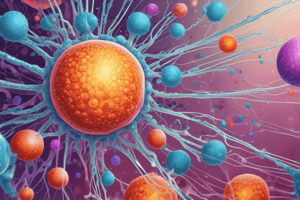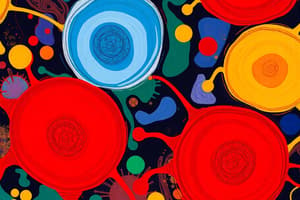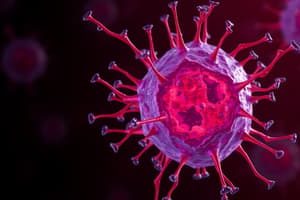Podcast
Questions and Answers
Which molecule is responsible for making pores on the surface of target cells?
Which molecule is responsible for making pores on the surface of target cells?
- Perforins (correct)
- TCR
- CD40
- B7
What type of cell presents an identical peptide on MHC I to the CD8+ T cell?
What type of cell presents an identical peptide on MHC I to the CD8+ T cell?
- B cell
- Naïve Th cell
- Target cell (correct)
- Macrophage
Which type of cell will a Th0 cell become based on cytokine signal?
Which type of cell will a Th0 cell become based on cytokine signal?
- Naïve Th cell
- CD8+ T cell
- B cell
- Effector cell (Th1, Th2, Th17) (correct)
Which molecule is involved in the interaction of CD4 and MHC II?
Which molecule is involved in the interaction of CD4 and MHC II?
Which molecule is responsible for the ligand-receptor type interaction of B7 and CD28?
Which molecule is responsible for the ligand-receptor type interaction of B7 and CD28?
Which signaling molecule is assumed to cause a Th0 cell to become a Th2 cell?
Which signaling molecule is assumed to cause a Th0 cell to become a Th2 cell?
Which cells release oxidative enzymes into the target cell?
Which cells release oxidative enzymes into the target cell?
Which molecule is involved in the interaction of pMHC II and TCR?
Which molecule is involved in the interaction of pMHC II and TCR?
Which molecule is responsible for the release of other soluble factors such as TNF?
Which molecule is responsible for the release of other soluble factors such as TNF?
Which molecule is involved in the interaction of CD40 and CD40?
Which molecule is involved in the interaction of CD40 and CD40?
Which molecule is responsible for the ligand-receptor type interaction of CD40 and CD40?
Which molecule is responsible for the ligand-receptor type interaction of CD40 and CD40?
Which molecule is involved in the immunological synapse?
Which molecule is involved in the immunological synapse?
Which T cell subset is responsible for cytokine production and cell-to-cell contact for activation?
Which T cell subset is responsible for cytokine production and cell-to-cell contact for activation?
Which type of cells recognize microbes via various receptors including pattern-recognition receptors (PRR) and present peptides to T cells for recognition?
Which type of cells recognize microbes via various receptors including pattern-recognition receptors (PRR) and present peptides to T cells for recognition?
What type of mitogen triggers ALL (T or B) lymphocytes to activation, undergo blast transformation, and cause resting cells to divide?
What type of mitogen triggers ALL (T or B) lymphocytes to activation, undergo blast transformation, and cause resting cells to divide?
What is the function of a superantigen?
What is the function of a superantigen?
What is the fate of mature T cells after encountering their specific antigen and receiving appropriate accessory signals?
What is the fate of mature T cells after encountering their specific antigen and receiving appropriate accessory signals?
Which T cell subset is responsible for cytokine production and cell-to-cell contact for suppression?
Which T cell subset is responsible for cytokine production and cell-to-cell contact for suppression?
What triggers blast transformation in T cells?
What triggers blast transformation in T cells?
Which molecule derived from microbial organisms stimulates lymphocytes by binding to the TCR, outside of the antigen-binding site?
Which molecule derived from microbial organisms stimulates lymphocytes by binding to the TCR, outside of the antigen-binding site?
What is the primary function of dendritic cells (DC) in the immune response?
What is the primary function of dendritic cells (DC) in the immune response?
What is the role of polyclonal mitogens in triggering lymphocytes?
What is the role of polyclonal mitogens in triggering lymphocytes?
What is the consequence of mature T cells encountering their specific antigen and receiving appropriate accessory signals?
What is the consequence of mature T cells encountering their specific antigen and receiving appropriate accessory signals?
Flashcards are hidden until you start studying



